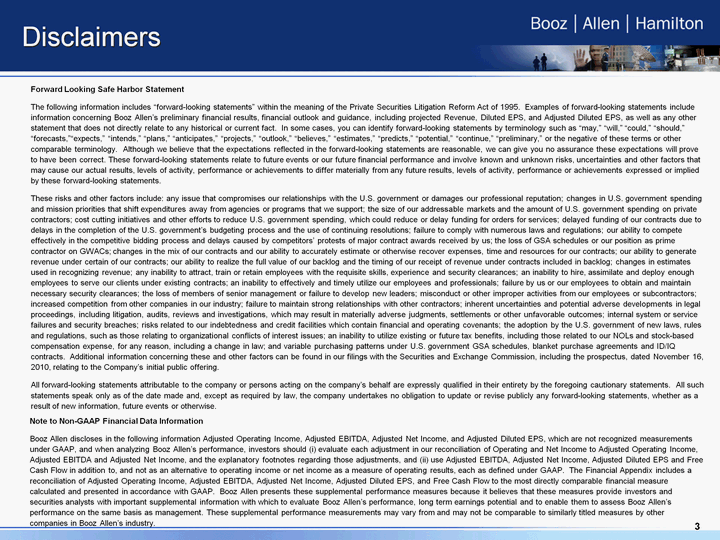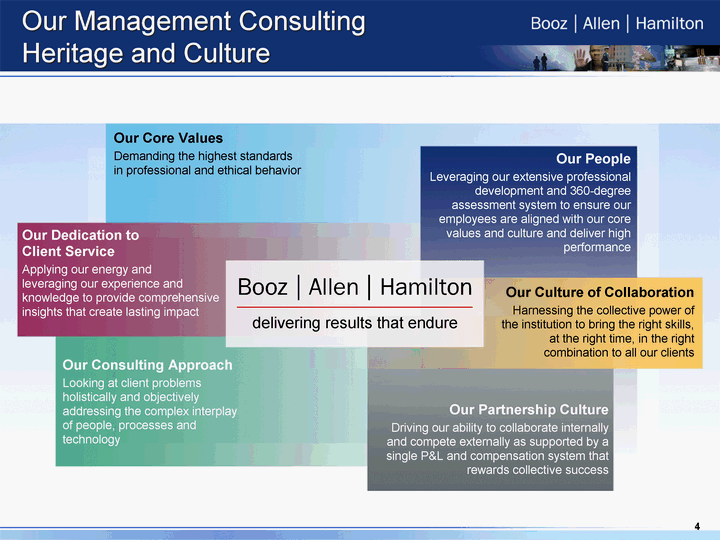Attached files
| file | filename |
|---|---|
| 8-K - FORM 8-K - Booz Allen Hamilton Holding Corp | w81557ae8vk.htm |
| EX-99.1 - EX-99.1 - Booz Allen Hamilton Holding Corp | w81557aexv99w1.htm |
Exhibit 99.2

| Booz Allen Hamilton Third Quarter Fiscal 2011 February 9, 2011 |

| 2 Today's Agenda Kevin Cook Vice President of Finance and Corporate Controller Introduction Ralph Shrader Chairman, Chief Executive Officer and President Management Overview Sam Strickland Executive Vice President and Chief Financial Officer Financial Overview Questions and Answers |

| 3 Disclaimers Forward Looking Safe Harbor Statement The following information includes "forward-looking statements" within the meaning of the Private Securities Litigation Reform Act of 1995. Examples of forward-looking statements include information concerning Booz Allen's preliminary financial results, financial outlook and guidance, including projected Revenue, Diluted EPS, and Adjusted Diluted EPS, as well as any other statement that does not directly relate to any historical or current fact. In some cases, you can identify forward-looking statements by terminology such as "may," "will," "could," "should," "forecasts,""expects," "intends," "plans," "anticipates," "projects," "outlook," "believes," "estimates," "predicts," "potential," "continue," "preliminary," or the negative of these terms or other comparable terminology. Although we believe that the expectations reflected in the forward-looking statements are reasonable, we can give you no assurance these expectations will prove to have been correct. These forward-looking statements relate to future events or our future financial performance and involve known and unknown risks, uncertainties and other factors that may cause our actual results, levels of activity, performance or achievements to differ materially from any future results, levels of activity, performance or achievements expressed or implied by these forward-looking statements. These risks and other factors include: any issue that compromises our relationships with the U.S. government or damages our professional reputation; changes in U.S. government spending and mission priorities that shift expenditures away from agencies or programs that we support; the size of our addressable markets and the amount of U.S. government spending on private contractors; cost cutting initiatives and other efforts to reduce U.S. government spending, which could reduce or delay funding for orders for services; delayed funding of our contracts due to delays in the completion of the U.S. government's budgeting process and the use of continuing resolutions; failure to comply with numerous laws and regulations; our ability to compete effectively in the competitive bidding process and delays caused by competitors' protests of major contract awards received by us; the loss of GSA schedules or our position as prime contractor on GWACs; changes in the mix of our contracts and our ability to accurately estimate or otherwise recover expenses, time and resources for our contracts; our ability to generate revenue under certain of our contracts; our ability to realize the full value of our backlog and the timing of our receipt of revenue under contracts included in backlog; changes in estimates used in recognizing revenue; any inability to attract, train or retain employees with the requisite skills, experience and security clearances; an inability to hire, assimilate and deploy enough employees to serve our clients under existing contracts; an inability to effectively and timely utilize our employees and professionals; failure by us or our employees to obtain and maintain necessary security clearances; the loss of members of senior management or failure to develop new leaders; misconduct or other improper activities from our employees or subcontractors; increased competition from other companies in our industry; failure to maintain strong relationships with other contractors; inherent uncertainties and potential adverse developments in legal proceedings, including litigation, audits, reviews and investigations, which may result in materially adverse judgments, settlements or other unfavorable outcomes; internal system or service failures and security breaches; risks related to our indebtedness and credit facilities which contain financial and operating covenants; the adoption by the U.S. government of new laws, rules and regulations, such as those relating to organizational conflicts of interest issues; an inability to utilize existing or future tax benefits, including those related to our NOLs and stock-based compensation expense, for any reason, including a change in law; and variable purchasing patterns under U.S. government GSA schedules, blanket purchase agreements and ID/IQ contracts. Additional information concerning these and other factors can be found in our filings with the Securities and Exchange Commission, including the prospectus, dated November 16, 2010, relating to the Company's initial public offering. All forward-looking statements attributable to the company or persons acting on the company's behalf are expressly qualified in their entirety by the foregoing cautionary statements. All such statements speak only as of the date made and, except as required by law, the company undertakes no obligation to update or revise publicly any forward-looking statements, whether as a result of new information, future events or otherwise. Note to Non-GAAP Financial Data Information Booz Allen discloses in the following information Adjusted Operating Income, Adjusted EBITDA, Adjusted Net Income, and Adjusted Diluted EPS, which are not recognized measurements under GAAP, and when analyzing Booz Allen's performance, investors should (i) evaluate each adjustment in our reconciliation of Operating and Net Income to Adjusted Operating Income, Adjusted EBITDA and Adjusted Net Income, and the explanatory footnotes regarding those adjustments, and (ii) use Adjusted EBITDA, Adjusted Net Income, Adjusted Diluted EPS and Free Cash Flow in addition to, and not as an alternative to operating income or net income as a measure of operating results, each as defined under GAAP. The Financial Appendix includes a reconciliation of Adjusted Operating Income, Adjusted EBITDA, Adjusted Net Income, Adjusted Diluted EPS, and Free Cash Flow to the most directly comparable financial measure calculated and presented in accordance with GAAP. Booz Allen presents these supplemental performance measures because it believes that these measures provide investors and securities analysts with important supplemental information with which to evaluate Booz Allen's performance, long term earnings potential and to enable them to assess Booz Allen's performance on the same basis as management. These supplemental performance measurements may vary from and may not be comparable to similarly titled measures by other companies in Booz Allen's industry. |

| 4 Our Management Consulting Heritage and Culture delivering results that endure Our Core Values Demanding the highest standards in professional and ethical behavior Our People Leveraging our extensive professional development and 360-degree assessment system to ensure our employees are aligned with our core values and culture and deliver high performance Our Culture of Collaboration Harnessing the collective power of the institution to bring the right skills, at the right time, in the right combination to all our clients Our Partnership Culture Driving our ability to collaborate internally and compete externally as supported by a single P&L and compensation system that rewards collective success Our Consulting Approach Looking at client problems holistically and objectively addressing the complex interplay of people, processes and technology Our Dedication to Client Service Applying our energy and leveraging our experience and knowledge to provide comprehensive insights that create lasting impact |

| 5 Key Financial Highlights Preliminary Third Quarter Fiscal 2011 Results Revenue $1.4 billion Up 10.1% Total Backlog $11 billion Up 21.4% Net Income $24 million Up from $1 million Adjusted Net Income $35 million Up 70.3% Adjusted EBITDA $106 million Up 23.1% Diluted EPS $0.18/share Up from $0.01/share Adjusted Diluted EPS $0.27/share Up from $0.17/share |

| Outlook 6 Revenue increase forecast: 9.1% - 9.5% Diluted EPS forecast: $0.53 - $0.57 Adjusted Diluted EPS forecast: $1.09 - $1.13 Fiscal 2011 Outlook Revenue increase forecast: High single to low double digits Diluted EPS forecast: $1.26 - $1.36 Adjusted Diluted EPS forecast: $1.45 - $1.55 Fiscal 2012 Outlook |

| Economic Value Drivers Broad client access with numerous contract vehicles Efficient use of resources driven by matrix approach and high partner-to-staff leverage Highly responsive recruiting approach to hire the right talent as backlog demands Highly aligned management compensation and incentive system Forward looking investment strategy 7 |

| 8 Financial Appendix |

| Booz Allen Hamilton Holding Corporation Non-GAAP Financial Information 9 "Adjusted Operating Income" represents Operating Income before (i) certain stock option-based and other equity-based compensation expenses, (ii) the impact of the application of purchase accounting, (iii) adjustments related to the amortization of intangible assets. Booz Allen prepares Adjusted Operating Income to eliminate the impact of items it does not consider indicative of ongoing operating performance due to their inherent unusual, extraordinary or non- recurring nature or because they result from an event of a similar nature. "Adjusted EBITDA" represents net income before income taxes, net interest and other expense and depreciation and amortization and before certain other items, including: (i) certain stock option-based and other equity-based compensation expenses, (ii) transaction costs, fees, losses, and expenses, (iii) the impact of the application of purchase accounting and (iv) any extraordinary, unusual or non-recurring items. Booz Allen prepares Adjusted EBITDA to eliminate the impact of items it does not consider indicative of ongoing operating performance due to their inherent unusual, extraordinary or non-recurring nature or because they result from an event of a similar nature. "Adjusted Net Income" represents net income before: (i) certain stock option-based and other equity-based compensation expenses, (ii) transaction costs, fees, losses, and expenses, including fees associated with debt prepayments, (iii) the impact of the application of purchase accounting, (iv) adjustments related to the amortization of intangible assets, (v) amortization or write-off of debt issuance costs and write-off of original issue discount, or OID, and (vi) any extraordinary, unusual or non-recurring items, in each case net of the tax effect calculated using an assumed effective tax rate. Booz Allen prepares Adjusted Net Income to eliminate the impact of items, net of tax, it does not consider indicative of ongoing operating performance due to their inherent unusual, extraordinary or non-recurring nature or because they result from an event of a similar nature. "Adjusted Diluted EPS" represents Diluted EPS calculated using Adjusted Net Income as opposed to Net Income. "Free Cash Flow" represents cash flow from operating activities net of investments in property and equipment. |

| Booz Allen Hamilton Holding Corporation Non-GAAP Financial Information Non-GAAP Financial Information Non-GAAP Financial Information 10 (a) Reflects stock-based compensation expense for options for Class A common stock and restricted shares, in each case, issued in connection with the acquisition under the Officer's Rollover Stock Plan that was established in connection with the acquisition. Also reflects stock-based compensation expense for Equity Incentive Plan Class A common stock options issued in connection with the acquisition under the Equity Incentive Plan that was established in the connection with the acquisition. (b) Reflects adjustments resulting from the application of purchase accounting in connection with the acquisition not otherwise included in depreciation and amortization. (c) Reflects amortization of intangible assets resulting from the acquisition. (d) Fiscal 2010 reflects costs related to the modification of our credit facilities, the establishment of the Tranche C term loan facility under our senior secured credit facilities and the related payment of special dividends. The nine months ended December 31, 2010 reflects certain external administrative and other expenses incurred in connection with the initial public offering. (e) Fiscal 2010 reflects costs related to the modification of our credit facilities, the establishment of the Tranche C term loan facility under our senior secured credit facilities and the related payment of special dividends. The nine months ended December 31, 2010 reflects certain external administrative and other expenses incurred in connection with the initial public offering and prepayment fees associated with early repayments of the mezzanine term loan. (f) Reflects the release of uncertain tax reserves, net of tax. (g) Reflects tax adjustments at an assumed marginal tax rate of 40%. |
